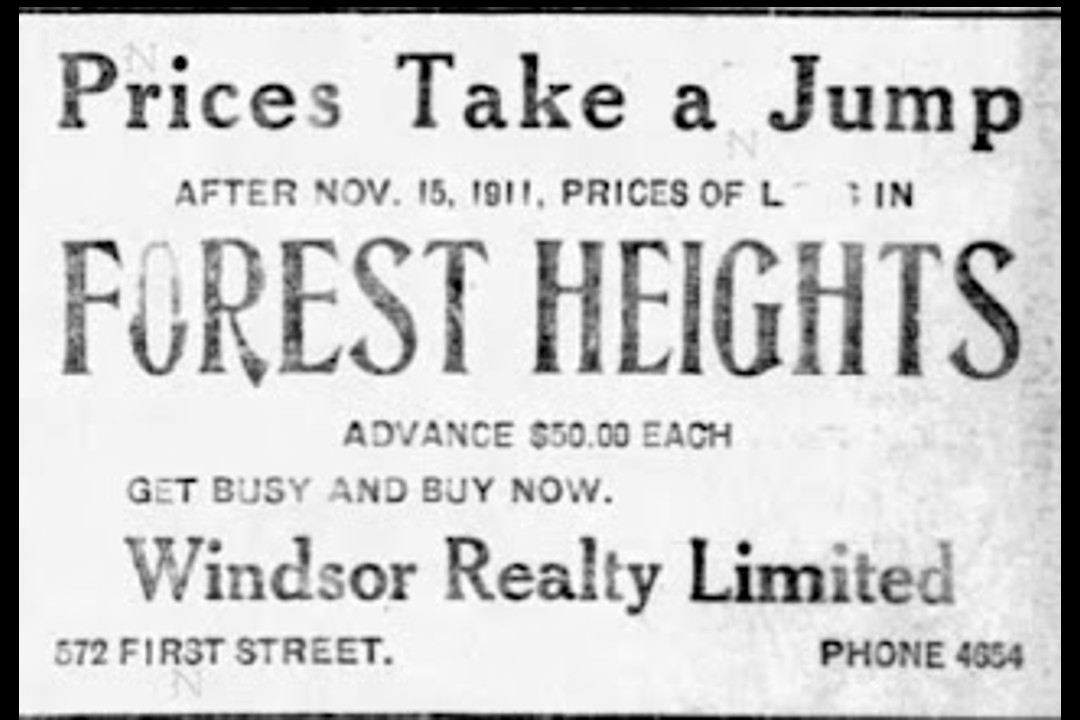On this day in 1911, plots of land for the future Forest Heights neighbourhood were being advertised for sale.
The ad warned potential buyers that the plots were about to get more expensive, and it demanded a $50 deposit (less than $1,500 in 2024 dollars) to buy in now.
Forest Heights was created by Windsor Realty, a local real estate company. It was one of several neighbourhoods planned to accommodate Edmonton's rapid population growth in the 1900s.
Tucked into a bend on the southern bank of the North Saskatchewan River, in 1911 the area was mostly agricultural land but was already home to Edmonton's Jewish cemetery, which was founded by Abraham Cristall in 1907 along what's now 76 Street NW and 101 Avenue NW. For many years, the cemetery housed only grave sites and a small wooden shed. In 1930, a permanent chapel was erected. A cenotaph was added following the Second World War, and in the 1970s, a Holocaust memorial was built. The cemetery remains in operation to this day, and serves all denominations of Judaism.
In 1913, Forest Heights was absorbed to become part of Edmonton, but development stalled soon after. The wild prosperity of the 1900s began to slow in the 1910s, and after 1914, with the outbreak of the First World War, it slowed further. There was far less need for new housing, and this spelled the end of many neighbourhoods planned during the previous decade.
Development in Forest Heights remained frozen until the second half of the 1950s. Following the Second World War, demand for housing quickly spiked again, and the farmland at the edge of the city quickly became in demand, with new detached homes being built. By the mid 1950s, so much construction was occurring that homes spilled into the area east of Forest Heights, which the city also annexed. That area became Terrace Heights. Both neighbourhoods eventually formed a common community league.
While thousands were moving to Forest Heights at this point, even more were moving through it. The neighbourhood's 101 Avenue NW had developed into the main route downtown for drivers arriving from the east. This remained the case until the early 1970s, when both the Yellowhead Highway and the James MacDonald Bridge were built, drawing drivers away from Forest Heights.
For many years, the well-known Patricia Motel remained as a reminder of the busy highway times. When it was built in 1957 (directly beside the cemetery, in fact), the motel was described as a modern accommodation. However, once the traffic on 101 Avenue lessened, the motel hit hard times. For decades, it was considered an eyesore, with frequent police and paramedic activity. The Patricia Motel was razed in 2019. A seniors' home is proposed for the lot.
Now that 101 Avenue NW is no longer the commuter route it was until the 1970s, the city has proposed changes to remake it into a street more in keeping with its neighbourhood. A concept plan was finalized in 2022 that would see bike lanes, landscaping, and other elements built along the avenue. However, that plan remains unfunded.
This clipping was found on Vintage Edmonton, a daily look at Edmonton's history from armchair archivist @revRecluse of @VintageEdmonton.

